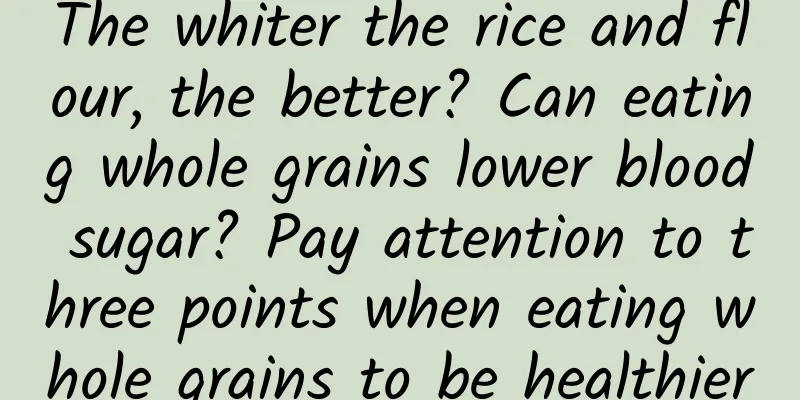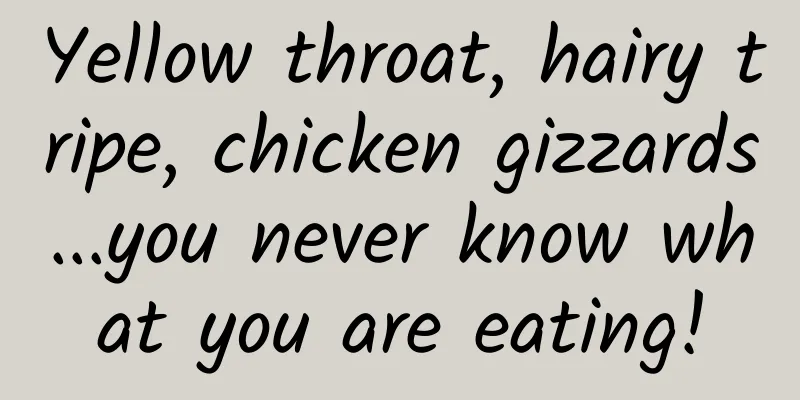The whiter the rice and flour, the better? Can eating whole grains lower blood sugar? Pay attention to three points when eating whole grains to be healthier

|
Author: Zhang Yu, researcher at the Chinese Center for Disease Control and Prevention, supervisor of medical doctorate and master's degree students Reviewer: Chen Ran, Associate Research Librarian (Science Communication) / Senior Engineer, COFCO Nutrition and Health Research Institute A good harvest is not only a manifestation of agricultural civilization, but also a manifestation of spiritual civilization. In ancient times, the five grains were rice, wheat, beans, corn, and vegetables. A good harvest symbolizes harvest, good harvest, and happiness, and farmland is the foundation for all of this. Therefore, the importance of farmland is particularly important in ancient and modern times, both in China and abroad. Nowadays, due to health and other factors, the public's attitude towards staple food is also changing. More and more people prefer coarse grains, but there are also some misunderstandings and rumors. Today, let's sort out the 8 major rumors about grains and see how many you believe. Copyrighted stock images, no reproduction is authorized 01 Rumor: Does the fading of black rice after soaking mean it has been dyed? Analysis: It is normal for black rice to fade due to soaking. Different from ordinary rice, the outer layer of black rice is black, which is actually caused by the richness of a special phytochemical substance, namely anthocyanin . Anthocyanin, also known as flower pigment, is a kind of water-soluble natural pigment widely found in plants in nature. It is a colored aglycone obtained by the hydrolysis of anthocyanin. Most of the main coloring substances in fruits, vegetables and flowers are related to it. Anthocyanin is a soluble pigment that dissolves in water during soaking and kneading, causing the color of both the rice and the water to change. This is not caused by dyeing. In addition, although the surface of black rice is black, its core is white. If the outer layer of black rice is scratched during washing, revealing the white core, this is also a normal phenomenon. 02 Rumor: The whiter the staple foods such as rice and flour, the better? Analysis: The more finely the rice flour is processed, the whiter it will be, but it will also result in a large loss of nutrients. Whole grains consist of four parts: bran, aleurone, endosperm and embryo, each of which is rich in different nutrients. During the fine processing, the bran, aleurone and embryo of the grains are separated, leaving only the endosperm with the highest starch content, while dietary fiber, B vitamins, minerals, etc. will be lost to varying degrees. Long-term consumption of refined white flour and rice is not good for health and can lead to insufficient intake of vitamins and minerals. At the same time, overly refined rice and flour also have a greater impact on blood sugar. Therefore, staple foods such as flour and rice are not necessarily better the whiter they are. 03 Rumor: Oats reduce bone density? Analysis: Changes in bone density are related to multiple factors, and long-term consumption of oats does not lead to a decrease in bone density. Factors that contribute to decreased bone density include age, lack of exercise, lack of protein and calcium in the diet, vitamin D deficiency, and diseases such as kidney disease and hyperthyroidism. Oats are high-fiber, low-calorie cereals that are rich in β-glucan and other functional ingredients. In addition, oats are rich in minerals such as calcium, phosphorus, iron, and zinc, which are beneficial to bone health. It is not the case that the high protein content in oats affects calcium absorption, accelerates calcium loss, and is not conducive to stabilizing bone health. 04 Rumor: Eating more buckwheat noodles can help you lose weight? Analysis: Buckwheat can assist in weight loss, but if you want to achieve the effect of losing weight you still need to strike a balance between eating and exercising. Compared with conventional staple foods such as rice and flour, buckwheat contains more dietary fiber, so it can give the eater a stronger sense of fullness. In reality, many people use buckwheat food as a substitute for staple food in weight loss meals, but it itself has no weight loss effect. The key to losing weight is to "control your mouth and move your legs". While controlling the total calorie intake, increase the amount of physical activity. Only by persisting in this way can you achieve more stable results. Copyrighted stock images, no reproduction is authorized 05 Rumor: Eating whole grains can lower blood sugar? Analysis: Eating whole grains does not lower blood sugar. The starch in cereals will increase blood sugar after digestion and absorption, so neither coarse grains nor refined grains have the effect of lowering blood sugar. However, the glycemic index of different foods is different, and therefore the effect on blood sugar is also different. Foods with a lower glycemic index have less impact on blood sugar fluctuations, and vice versa. Since there is more dietary fiber in whole grains, the sugar in them is released more slowly than in refined grains such as refined rice and white flour. At the same time, whole grains are emptied more slowly in the stomach, so the feeling of fullness is stronger, which helps to suppress appetite and reduce food intake. Therefore, eating coarse grains appropriately is helpful to stabilize blood sugar. For people with high blood sugar, it is still necessary to regulate it through regular medication and a reasonable lifestyle. 06 Rumor: The more whole grains you eat, the healthier you will be? Analysis: Eating whole grains in moderation is good for your health, but the more the better is not the case. Eating too much may affect your health. Whole grains are rich in dietary fiber and B vitamins, and contain more complete nutrition than refined rice and flour. Therefore, oatmeal, quinoa, brown rice, buckwheat, oats, barley, etc. should be added to the diet on a daily basis, but the total amount should also be controlled. According to the recommendations of the "Dietary Guidelines for Chinese Residents" (2022 edition), eat 50-150 grams of whole grains and miscellaneous beans and 50-100 grams of potatoes every day. On the one hand, whole grains are richer in dietary fiber, and eating too much may cause gastrointestinal discomfort. It will also significantly delay gastric emptying, cause acid reflux, and even cause damage to the esophageal mucosa. On the other hand, coarse grains and mixed grains are also grains, and the starch in them is still a source of calories. Eating too much will also affect blood sugar and cause obesity due to excess energy. 07 Rumor: Sweet potatoes can kill 98% of cancer cells and inhibit cancer? Analysis: The claim that sweet potatoes can prevent cancer is unscientific and there is no relevant research evidence. Sweet potatoes have high nutritional value. In addition to being rich in dietary fiber and carotene, they are also rich in more than 10 trace elements such as vitamin C, potassium, and iron. They are a good choice for staple food. In the Compendium of Materia Medica, it is also recorded that they can "replenish deficiency, strengthen qi and strength, and strengthen the spleen and stomach." The claim that sweet potatoes can fight cancer comes from a Japanese study that stated that sweet potato extract had a high cancer inhibition rate in in vitro tests. On the one hand , the authenticity of the research conclusions is still controversial. On the other hand, sweet potato extract and edible sweet potatoes are two completely different things, and it is wrong to simply equate the results of in vitro studies with the effects in real life. So far, there are no reports indicating that eating sweet potatoes can have an anti-cancer effect. 08 Rumor: Is the “rice oil” in millet porridge of high nutritional value? Analysis: Millet has a low fat content, and "rice oil" does not have a high nutritional value. Cereal foods are rich in starch and relatively low in fat. Take millet as an example, the fat content is only 3.1 grams per 100 grams. After millet is boiled, the large-molecule starch will undergo hydrolysis to produce small-molecule dextrin. A small amount of fat and nutrients such as vitamin B1, vitamin B2 and potassium that are rich in unrefined millet will float on the surface of the porridge. After cooling slightly, they will become a thin layer of "rice oil". Although millet porridge is easier to digest, its nutritional value is not outstanding in general. Moreover, the "rice oil" content is not much, and it is not reliable to rely solely on it to improve physical condition, and there is no relevant clinical evidence. Copyrighted stock images, no reproduction is authorized Eat whole grains scientifically and rationally Three points to note . Scientific combination, more nutrition. From a nutritional point of view, the best way to eat is a balanced diet. On the basis of maintaining the diversity of staple food, increasing the types of coarse grains, adjusting the ratio of coarse and fine grains, and matching with appropriate meat, eggs and milk will bring more nutrition. 2. Eat in a reasonable quantity and don’t eat too fast. The amount of staple food should refer to the "Dietary Guidelines for Chinese Residents". At the same time, according to your own situation, on the basis of controlling the amount of staple food, you should appropriately increase or decrease the proportion of whole grains to what your body can tolerate. 3. Persist for a long time, don't follow the trend. The health effect of diet is slow, the key is to maintain a reasonable diet and stick to it for a long time. In addition, it is more important to choose a combination of grains that suits you. Blindly following the trend will only result in nothing. in conclusion The Yellow Emperor's Classic of Internal Medicine states: "Five grains are for nourishment, five fruits are for assistance, five animals are for benefit, and five vegetables are for filling. Take them with harmonious flavors to replenish essence and benefit qi." Whole grains are the basis of our life and nutrition. Only by making scientific and reasonable choices can we achieve more stable health. The article is produced by "Science Refutes Facts" (ID: Science_Facts). Please indicate the source when reprinting. The cover image and images within this article are from the copyright gallery. Reprinting and quoting them may lead to copyright disputes. |
<<: Where do the little fish that eat feet skin in foot massage shops go when they grow up?
>>: How terrible would it be to have a major earthquake that caused the fall of an empire?
Recommend
How much does it cost to be an agent for a food mini app in Hohhot?
What is the price of being an agent of Hohhot Foo...
The three stages of event operation: How to plan an event with 10,000 participants
Event operations stimulate the improvement of sho...
How can the education industry seize the opportunity of winter vacation and acquire customers accurately?
In the education industry, the era of "let&#...
Modularity and AR phones: Did Lenovo bet on the right trend?
Not long ago, Lenovo held the Tech World Technolo...
How to correctly place ads on TikTok?
1 Behind the TikTok phenomenon As of mid-June 201...
Google launches VR portable scene-based immersive games, which are closer to us
Whether it is a sci-fi movie with lifelike shots ...
Liang Huanzhen-Overclocking Context: All-Round English Storm Camp
: : : : : : : : : : : : : : : about? you1.pdf 6.67...
Hubei has zero new cases for the first time! No new local confirmed cases in 31 provinces, autonomous regions and municipalities
[#Hubei's first zero new cases#!#No new local...
Product Analysis | Zhihu App product operation analysis report!
From a niche elite community to a knowledge mento...
Of the six mobile phone features that have disappeared over the years, which one do you miss the most?
As mobile phone designs continue to change, many ...
Don't miss it! The biggest supermoon of the year is coming soon
Supermoon (data map) Photo by Li Jianji According...
Lanzhou lawyer mini program development function, how much does it cost to develop a lawyer legal consultation mini program?
Recently a friend consulted me and wanted to make...
Chen Changwen's method: Confessions of a community member
Every perceptive entrepreneur should practice soc...
An 8-year-old boy was swept into the air by a fountain and died. How scary is this fountain?
Some time ago, there was such a news on the hot s...
Can the combination of "salt" and "mirror" generate electricity? So easy! 24 hours a day!
Review expert: Zhu Guangsi, member of Beijing Sci...









